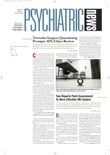Athlete A or team X, the top performers in their sport, sometimes lose to less-adept competitors. Lower-ranked athletes or teams, at their peak, may perform better than top-ranked ones at their worst. Even elite athletes aren't always at the top of their game.
Variations in sports performance may reflect normal ebb and flow of biological rhythms. Marked differences between time of training and time of competition—as commonly occur in figure skating and football—also may dent an athlete's performance, noted Teodor Postolache, M.D., an associate professor of psychiatry at the University of Maryland School of Medicine.
Postolache served as guest editor of the June Clinics in Sports Medicine, which explores applications of body-time research to sports performance. (This issue was published as a book, Sports Chronobiology, by Saunders.)
Normal mid-afternoon drowsiness, jet travel, seasonal and menstrual-cycle variations in body rhythms, and lack of sleep can take the edge off athletic skills, Postolache said. Chronobiology lab findings can help athletes perform at their peak and reduce their risk of injury.
Psychiatrists and psychologists working in medical school psychiatry departments report their research in some of the book's 18 articles.
Psychomotor Vigilance Declines
Hans Van Dongen, Ph.D., and David Dinges, Ph.D., of the University of Pennsylvania, described studies assessing psychomotor vigilance performance after sleep deprivation. This skill involves reaction time and sustained attention. It is needed for not only sports performance but also everyday activities such as driving. It is highly sensitive to sleep loss, often experienced by athletes on road trips, particularly after they cross multiple time zones.
Such performance deteriorates markedly after 88 hours of continuous wakefulness, a duration comparable to staying up for three nights and long enough to show circadian patterns of alertness and sleepiness. Performance is consistently better in the day than at night, a reflection of humans' innate programming to stay alert in the day and sleep at night. Two-hour nap opportunities every 12 hours can blunt deficits in psychomotor vigilance.
Naps have a downside, though. Right after awakening, people often manifest performance deficits termed “sleep inertia.” They're foggy and clumsy. This effect intensifies with progressive sleep loss, especially at night, Van Dongen and Dinges found. Very short naps—roughly 10 minutes—may offer some recuperative benefit when people are sleep deprived, they said, without producing noticeable levels of sleep inertia.
`Sleep Debt' Snowballs
Chronic sleep restriction, widespread among American adults, has serious adverse consequences for physical and mental performance, asserted sleep researcher William Dement, M.D., Ph.D., a professor of psychiatry at Stanford University. The most important aspect of the body's homeostatic regulation of sleep, he said, is that sleep loss is cumulative. “When total nightly sleep is reduced by exactly the same amount each night for several consecutive nights,” he reported, “the tendency to fall asleep in the daytime becomes progressively stronger each day.”
Dement calls this phenomenon “sleep debt.” As he explains, the brain records as a debt every hour of sleep that is less than a person's nightly requirement. This snowballing debt may include an hour of sleep lost a week or month ago, as well as the hour lost last night, he speculated. A large sleep debt can be reduced only by extra sleep.
In a landmark 1994 National Institute of Mental Health study, subjects stayed in bed in the dark 14 hours every night for 28 consecutive nights. At first, they slept as long as 12 hours a night, suggesting they entered the study with sizeable sleep debts, Dement said. By the fourth week, their sleep stabilized at a nightly average of eight hours and 15 minutes—a figure interpreted to mean that most adults need this amount of sleep each night.
Does `Secret' Advantage Accrue?
When subjects slept until “slept out,” their mood, energy level, and sense of well-being as indicated on daily questionnaires all improved. Athletes who obtain all the sleep they need, Dement suggested, might have a “secret” advantage over their competition.
The adage “practice makes perfect,” long a truism of athletic training, has been modified by sleep and chronobiology studies in the past decade, according to Matthew Walker, Ph.D., and Robert Stickgold, Ph.D., of Harvard Medical School. After initial training, the human brain continues to learn in the absence of further practice, they said. The improvement develops in sleep.
These findings have a direct application to athletes' training schedules, they asserted. Athletes who train consistently across the day and then cut short their sleep to get up early the next morning for practice might shortchange their brains of sleep-dependent consolidation and plasticity.
Studies of bright light's beneficial impact on mood hold relevance for the depressed athlete who experiences adverse effects from antidepressant medications or needs to avoid psychoactive substances entirely, said Postolache and Dan Oren, M.D., of Yale University School of Medicine. Bright light's antidepressant effects start sooner than those of most antidepressant medications, they noted. They suggest light exposure could be used to hasten antidepressant response.
“Athletes who obtain all the sleep they need might have a `secret' advantage over their competition.”
Injured athletes simultaneously may experience diminished feelings of competence and self-worth and undergo an abrupt decrement in light exposure due to reduction in outdoor training. Postolache and Oren recommended that sidelined athletes continue to get bright-light exposure, either natural or artificial.
The contents of and ordering information for Sports Chronobiology is posted at<www.intl.elsevierhealth.com/catalogue/title.cfm?ISBN=1416027696>.▪
